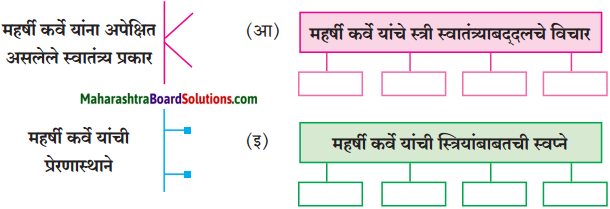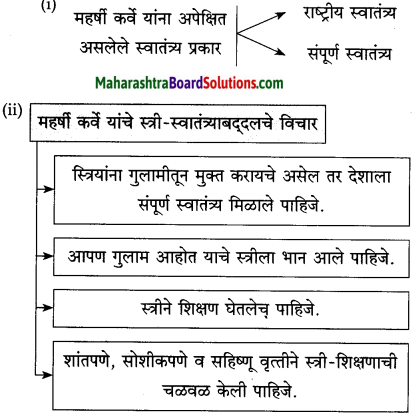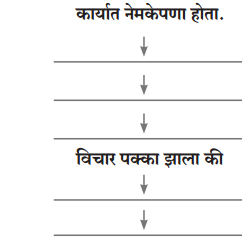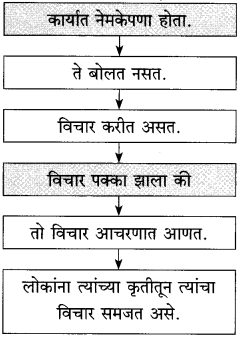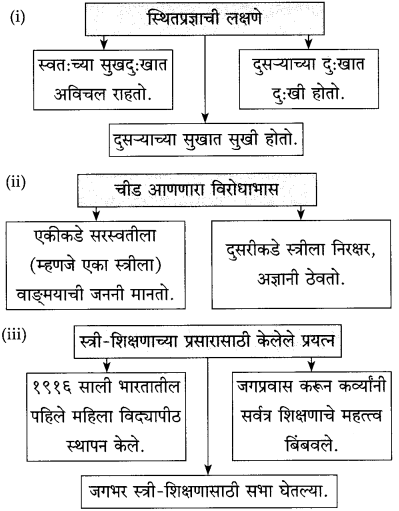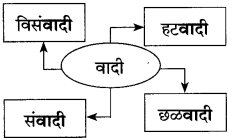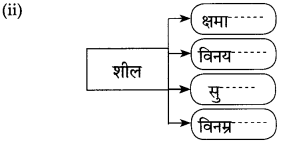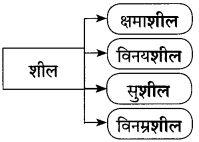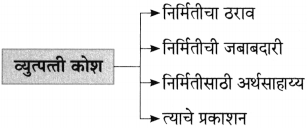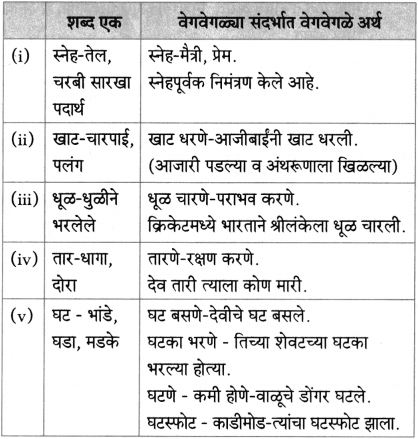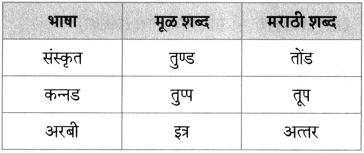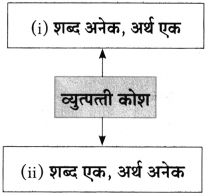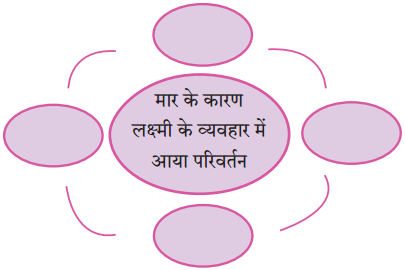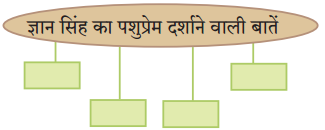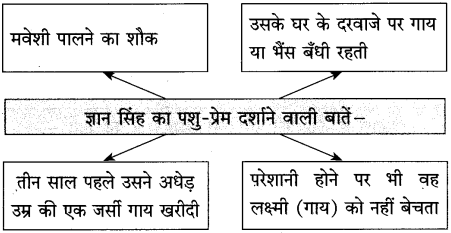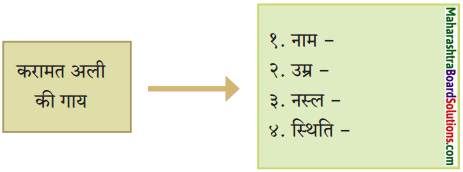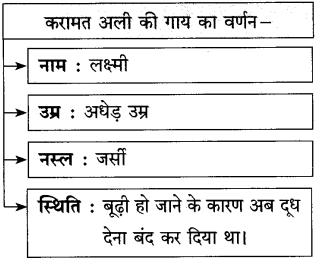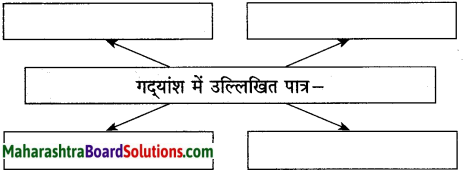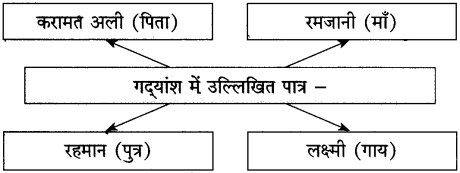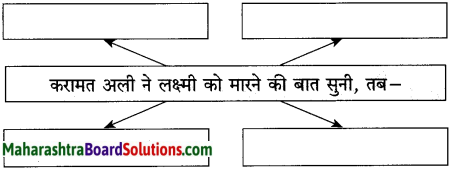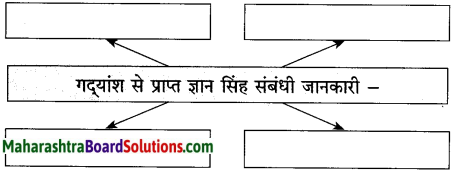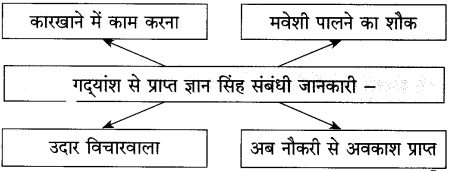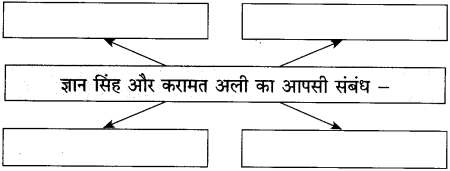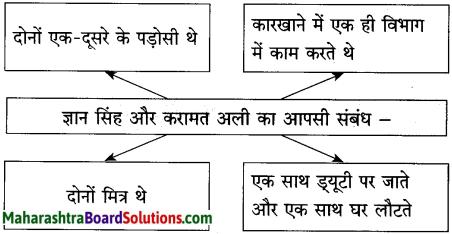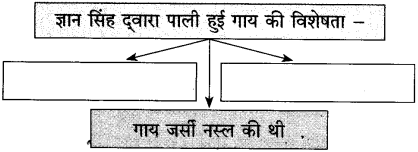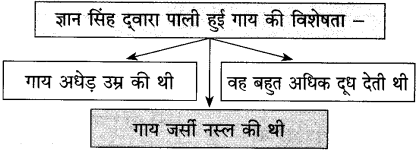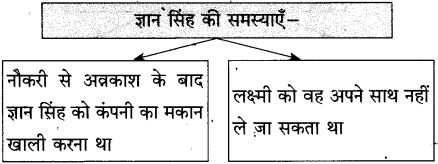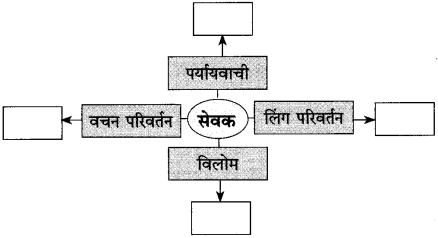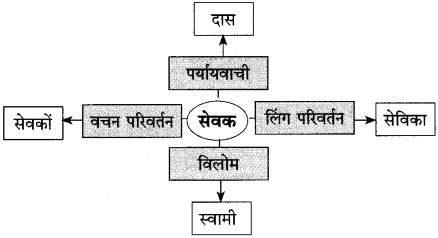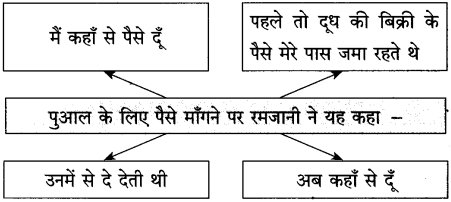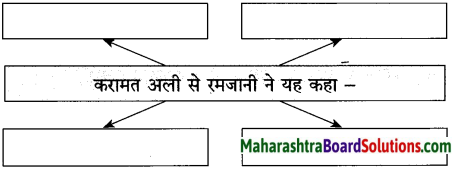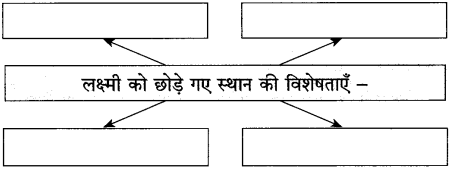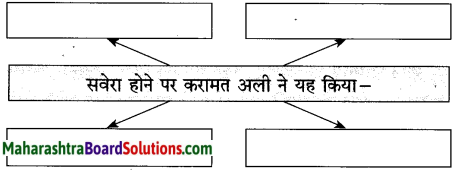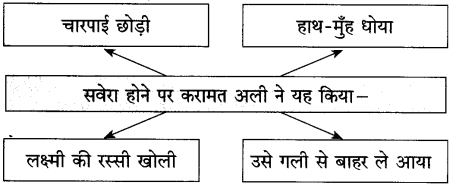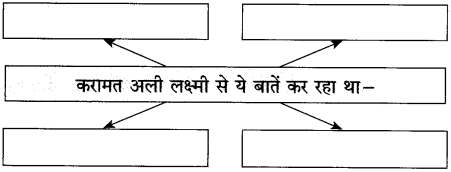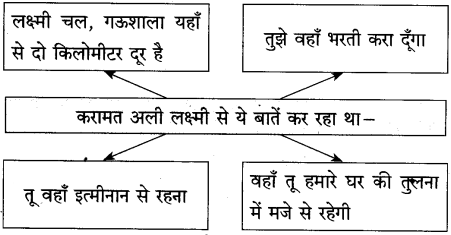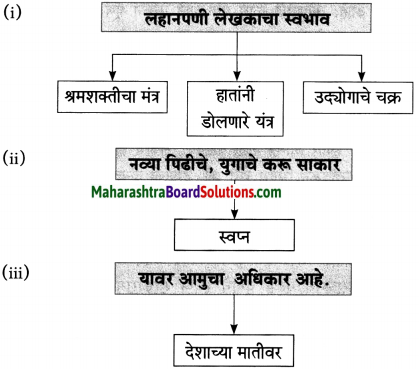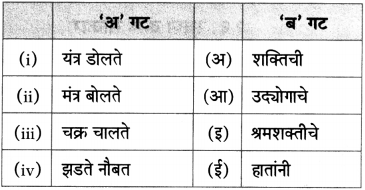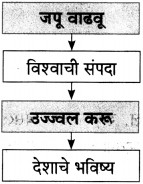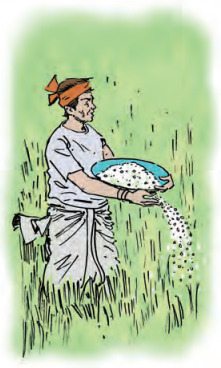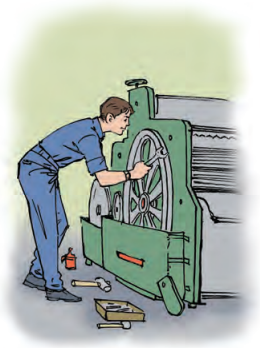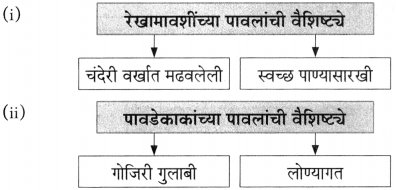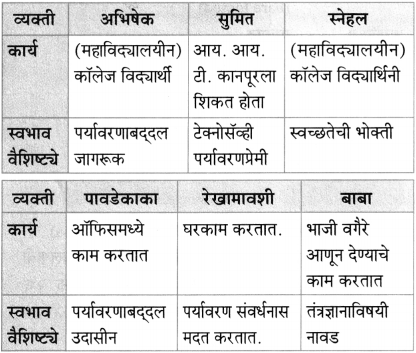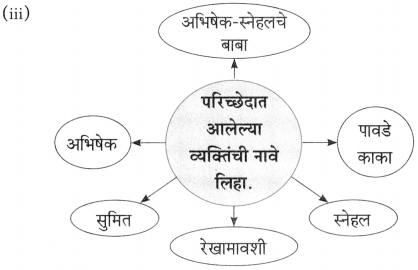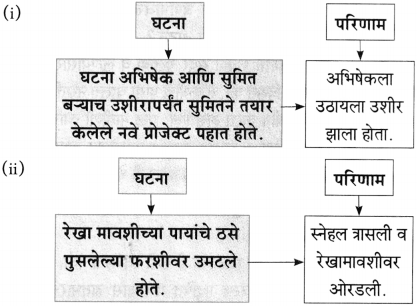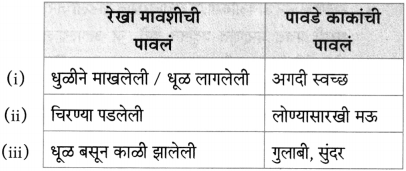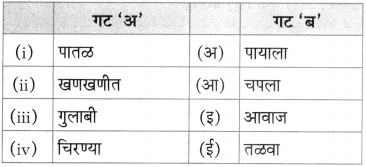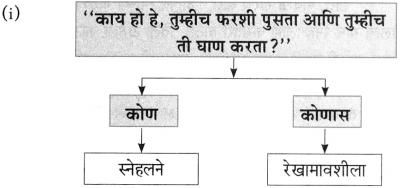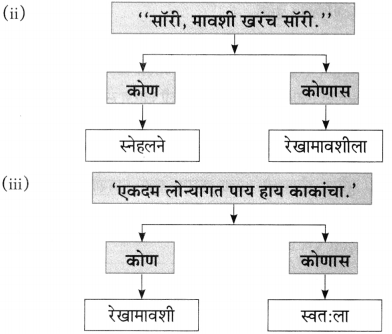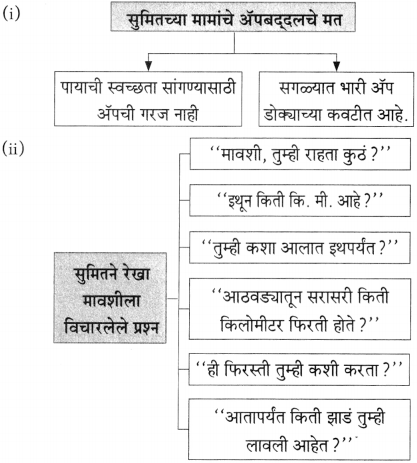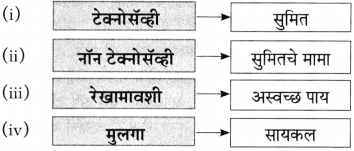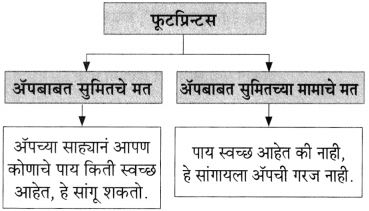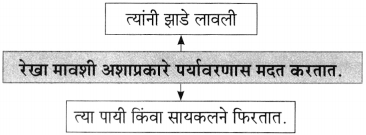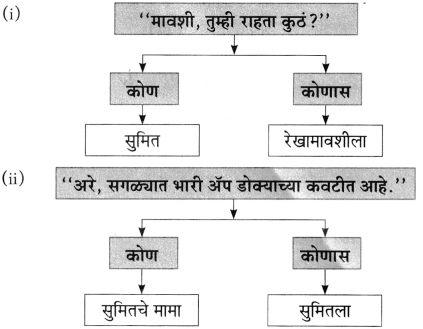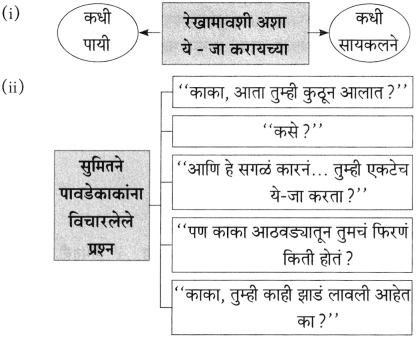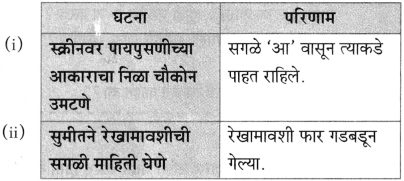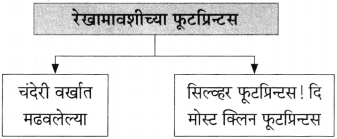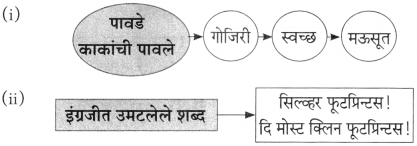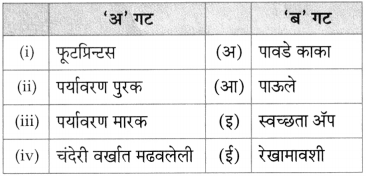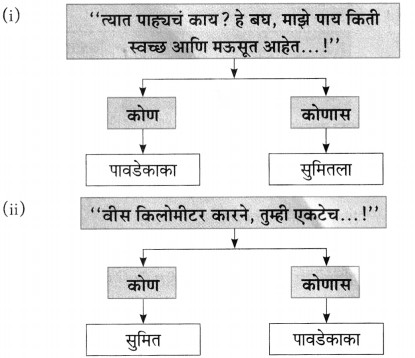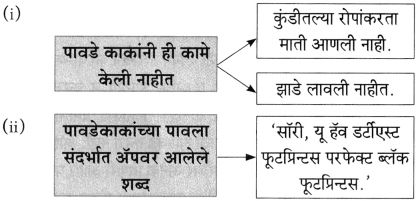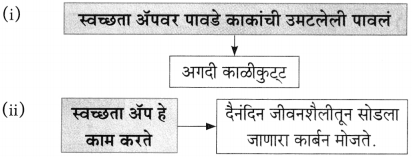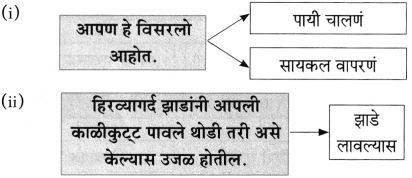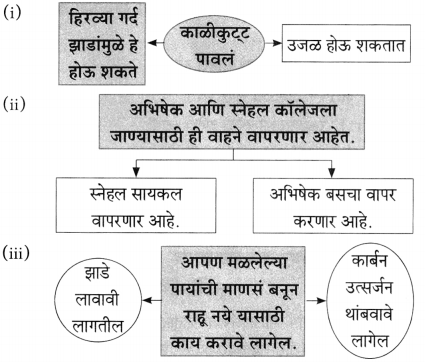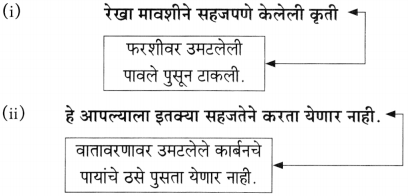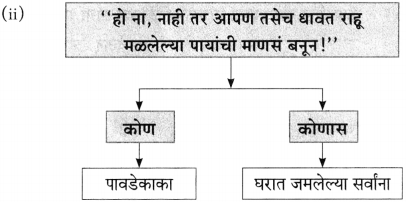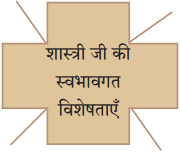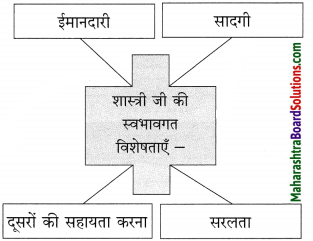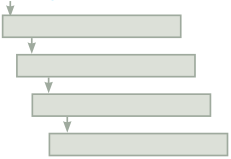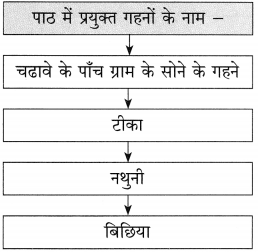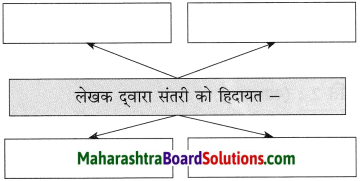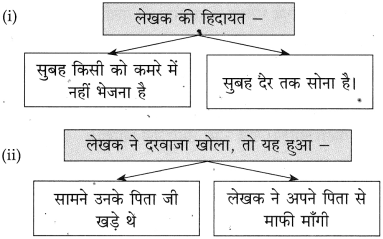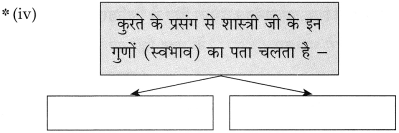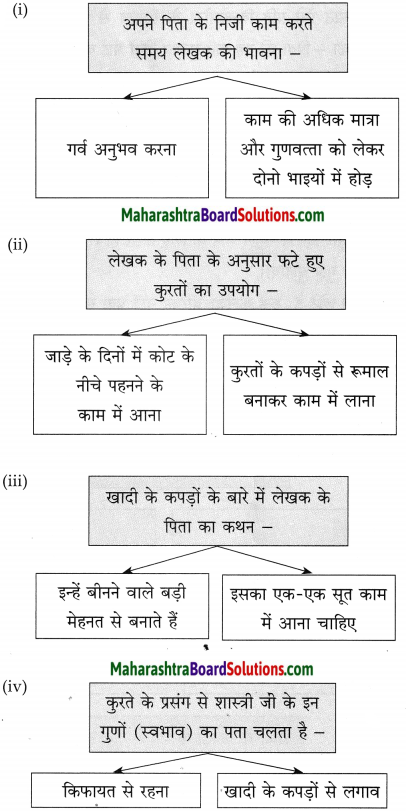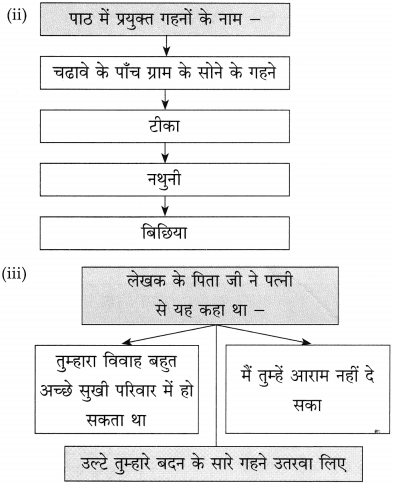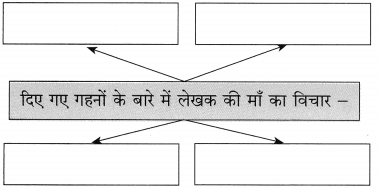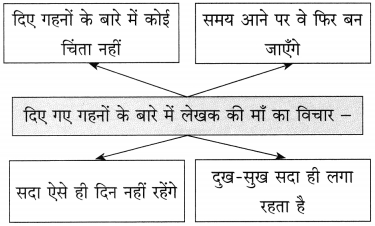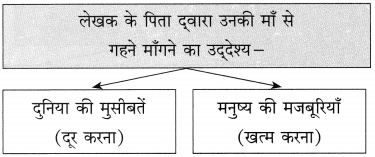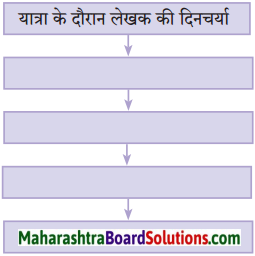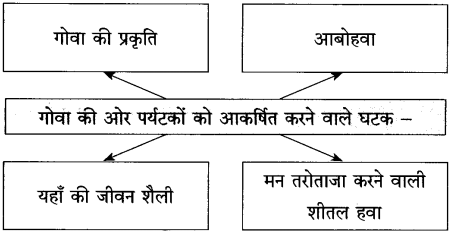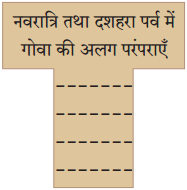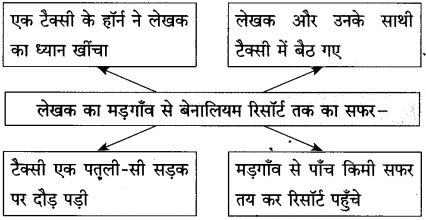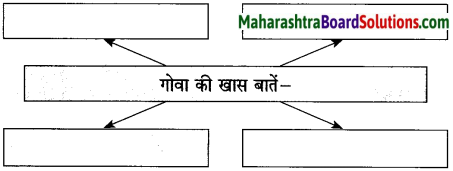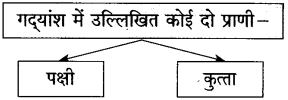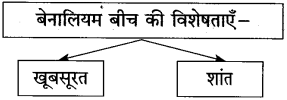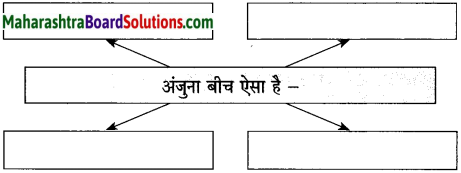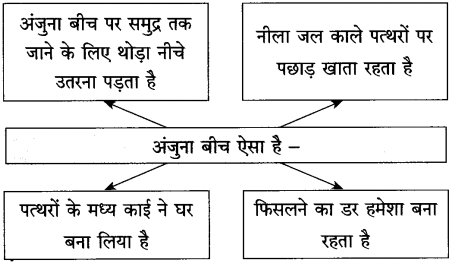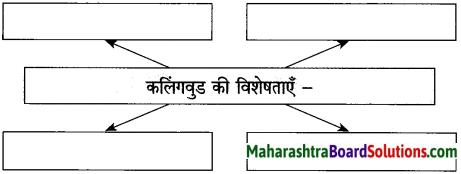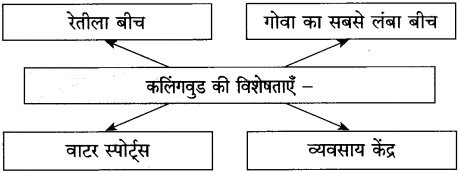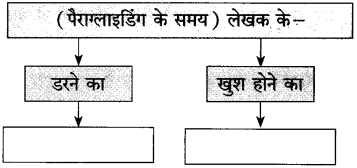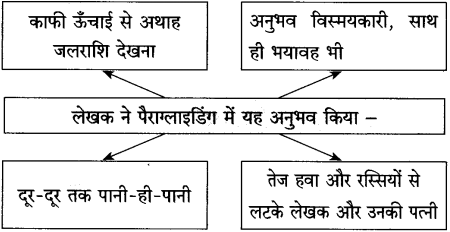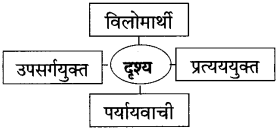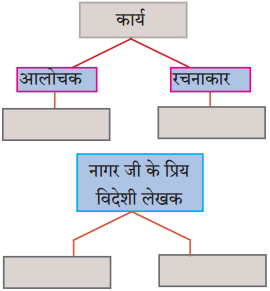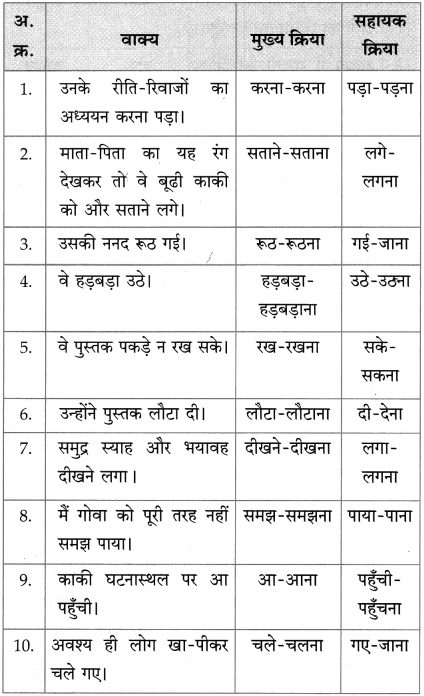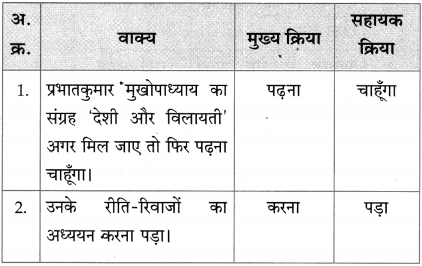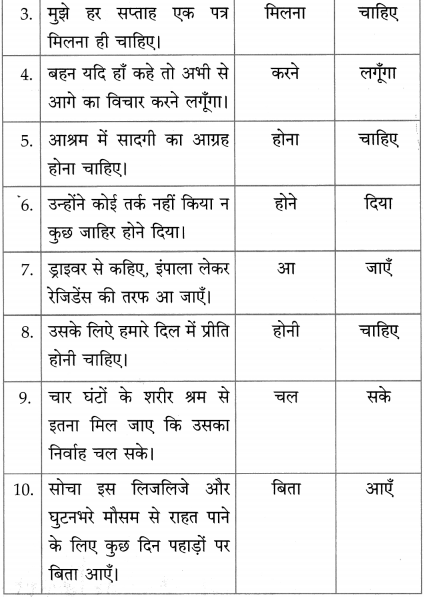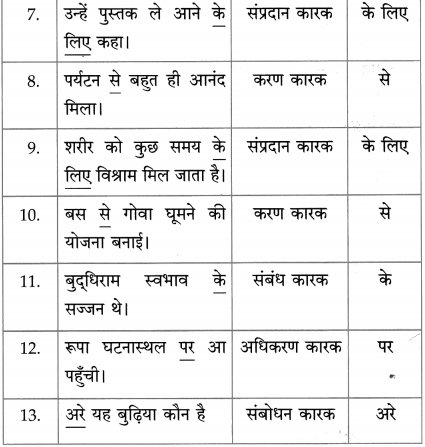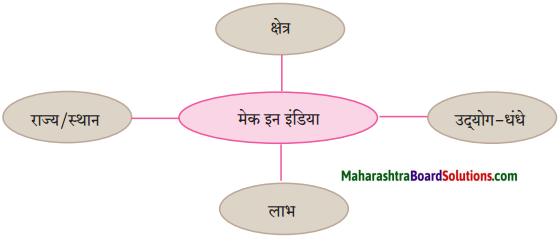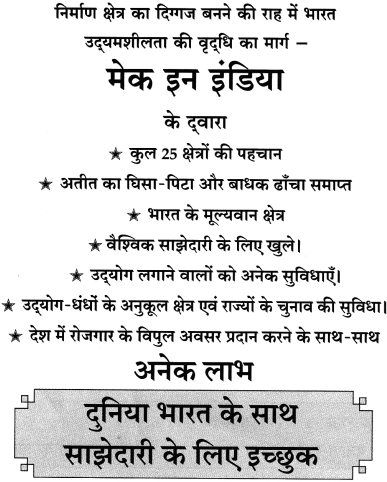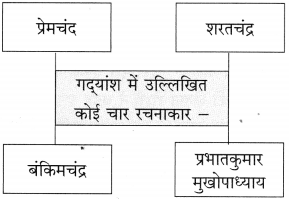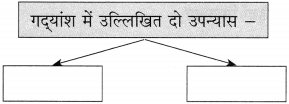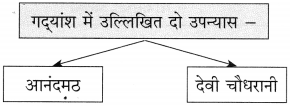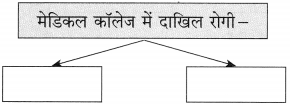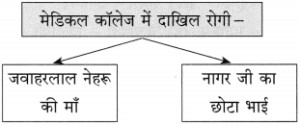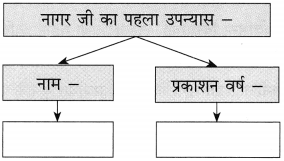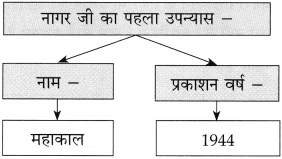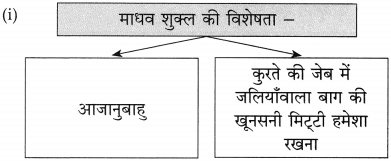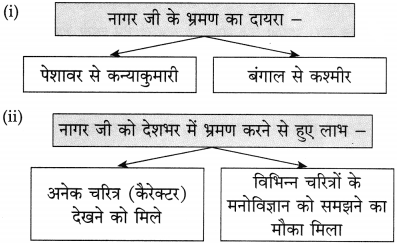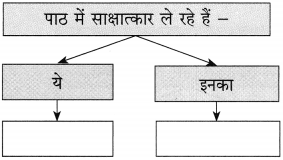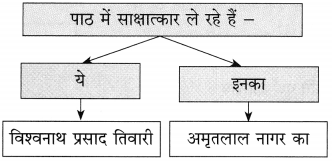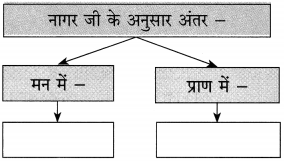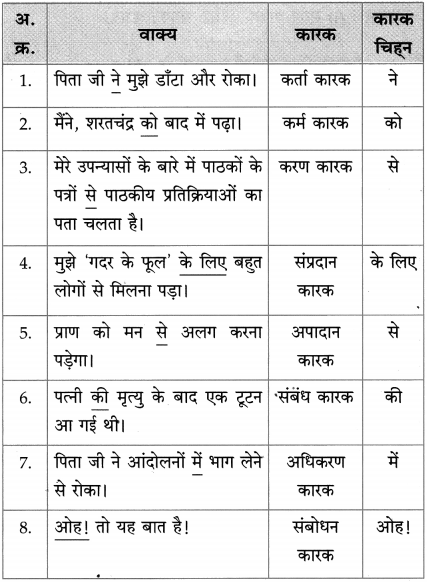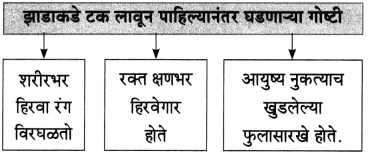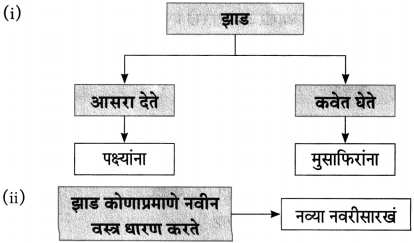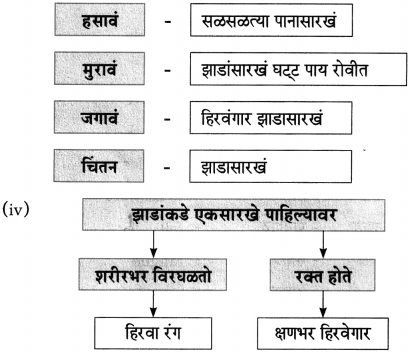Class 10th Marathi Kumarbharti Chapter 9 आश्वासक चित्र (कविता) Question Answer Maharashtra Board
Balbharti Maharashtra State Board Class 10 Marathi Solutions Kumarbharti Chapter 9 आश्वासक चित्र (कविता) Notes, Textbook Exercise Important Questions and Answers.
Std 10 Marathi Chapter 9 Question Answer
Marathi Kumarbharti Std 10 Digest Chapter 9 आश्वासक चित्र Textbook Questions and Answers
कृति
कृतिपत्रिकेतील प्रश्न २ (अ) साठी…
प्रश्न 1.
कवितेच्या आधारे खालील कोष्टक पूर्ण करा.
| कवितेचा विषय | कवितेतील पात्र | कवितेतील मूल्य | आश्वासक चित्र दर्शवणाऱ्या ओळी |
| …………………….. | …………………….. | …………………….. | …………………….. |
| …………………….. | …………………….. | …………………….. | …………………….. |
| …………………….. | …………………….. | …………………….. | …………………….. |
उत्तर:
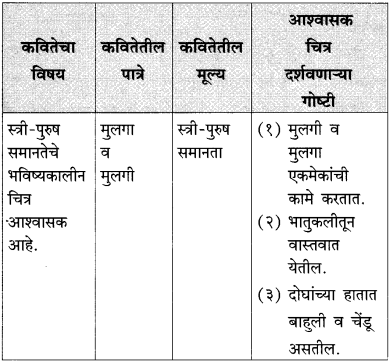
प्रश्न 2.
खालील शब्दसमूहांचा तुम्हाला समजलेला अर्थ लिहा.
(१) तापलेले ऊन …………………………………..
(२) आश्वासक चित्र …………………………………..
उत्तर:
(i) तापलेले ऊन – भविष्यातील धगधगते वास्तव होय.
(ii) आश्वासक चित्र – भविष्यात स्त्री-पुरुष समानता वास्तवात येईल, याचे आश्वासन होय.
![]()
प्रश्न 3.
मुलीचा आत्मविश्वास व्यक्त करणाऱ्या कवितेतील ओळी शोधा.
(अ) …………………………………..
(आ) …………………………………..
उत्तर:
(अ) मी दोन्ही करू शकते एकाच वेळी
(आ) उंच उडवलेला चेंडू आभाळाला शिवून नेमका येऊन पडतो तिच्या ओंजळीत.
प्रश्न 4.
चौकट पूर्ण करा.
कवयित्रीच्या मनातील आशावाद – [ ]
उत्तर:
भविष्यात स्त्री-पुरुषांमध्ये परस्पर स्नेहभाव व सामंजस्य निर्माण होईल.
प्रश्न 5.
कवितेतील खालील घटनेतून/विचारातून आढळणारा व्यक्तीचा गुण लिहा.
(अ) मांडी घालून मुलगा बसतो गॅससमोर [ ]
(आ) मी दोन्ही करू शकते एकाच वेळी [ ]
(इ) जिथे खेळले जातील सारेच खेळ एकाच वेळी [ ]
उत्तर:
(अ) मांडी घालून मुलगा बसतो गॅससमोर – सहकार्य
(आ) मी दोन्ही करू शकते एकाच वेळी – आत्मविश्वास
(इ) जिथे खेळले जातील सारेच खेळ एकाच वेळी – समजसपणा
प्रश्न 6.
काव्यसौंदर्य.
(अ) खालील ओळींचे तुमच्या शब्दांत रसग्रहण करा.
‘भातुकलीतून प्रवेशताना वास्तवात, हातात हात असेल दोघांचाही’
उत्तर :
आशयसौंदर्य : कवयित्री नीरजा यांनी ‘आश्वासक चित्र’ या कवितेमधून स्त्री-पुरुष समानतेचे भविष्यकालीन चित्र आश्वासकरीत्या कसे साकारले जाईल याची दिशा खेळणारा लहान मुलगा व मुलगी यांच्या प्रतीकांतून योग्यपणे दाखवली आहे…
काव्यसौंदर्य : भातुकलीतले जग हे स्वप्नाळू असते. त्यातला संसार हा लुटुपुटीचा असतो. मोठेपणी प्रत्यक्ष संसारातील जबाबदाऱ्या या वास्तववादी असतात. त्यामुळे भातुकलीच्या स्वप्नाळू जगातून प्रत्यक्ष वास्तवात प्रवेश करताना सत्य स्वीकारावे लागेल. स्त्री-पुरुष यांची परस्परांना स्नेहाची साथ असेल, तर समजूतदारपणाने व सहकार्याने ते जगात वावरतील. स्त्री-पुरुष परस्परांची कामे मिळून करतील, असे भविष्यकालीन आशावादी चित्र उपरोक्त ओळीतून साकारले आहे.
भाषिक वैशिष्ट्ये : या ओळींमधून लहान मुलांच्या खेळातून विचारगर्भ चिंतनाची प्रचिती येते. कवयित्रींनी साध्या विधानातून विचारगर्भ आशय थेट मांडला आहे. ‘स्त्री-पुरुष समानता’ हा अत्यंत जिव्हाळ्याचा विषय सहजपणे व्यक्त झाला आहे. भविष्यकालीन दोघांमधील सामंजस्याचे लोभस परंतु प्रगल्भ चित्र ‘हातात हात असेल’ या वाक्यखंडातून प्रत्ययकारीरीत्या प्रकट झाले आहे. स्वप्न आणि सत्य यांची योग्य सांगड तरल शब्दांत व्यक्त झाली आहे.
![]()
(आ) ‘ती म्हणते मी दोन्ही करू शकते एकाच वेळी. तू करशील?’ या ओळीचा तुम्हांला कळलेला अर्थ स्पष्ट करा.
उत्तर :
‘आश्वासक चित्र’ या कवितेमध्ये नीरजा यांनी आधुनिक जगातील स्त्रीचे सामर्थ्य व सहभाग यांविषयी दृढविश्वास व्यक्त करताना मुलीच्या तोंडी हे उद्गार लिहिले आहेत.
भातुकली खेळणारी मुलगी व चेंडू उडवून झेलणारा मुलगा उन्हाच्या आडोशाला खेळत आहेत, हे दृश्य कवयित्री खिडकीतून पाहत आहे. अचानक मांडीवरची बाहुली बाजूला ठेवून मुलगी चेंडू खेळणाऱ्या मुलापाशी जाते व चेंडू मागते. मुलगा तिला हिणवतो की, तू पाल्याची भाजीच कर, चेंडू उडवणे तुला जमणार नाही. तेव्हा मुलगी त्याला अत्यंत आत्मविश्वासाने म्हणते की, मी स्वयंपाक व चेंडू उडवणे हे दोन्ही एकाच वेळी करू शकते. तू माझे काम करशील का ? मुलीच्या उद्गारांतून कवयित्रींनी स्त्रीचे सामर्थ्य मार्मिकपणे विशद केले आहे.
(इ) कवितेतील मुलगा आणि मुलगी कशाचे प्रतिनिधित्व करतात असे तुम्हाला वाटते, तुमच्या शब्दांत लिहा.
उत्तर :
कवयित्री नीरजा यांनी स्त्री-पुरुष समानतेचे भविष्यकालीन ‘आश्वासक चित्र रंगवले आहे. कवितेतील मुलगा हे ‘पुरुषजातीचे’ प्रतीक आहे; तर मुलगी ही स्त्रीजातीचे प्रतिनिधित्व करते. स्त्री-पुरुष समानता ही संकल्पना अजून बाल्यावस्थेत असल्यामुळे स्त्री-पुरुष तत्व हे मुलगी व मुलगा या लहान वयात दाखवले आहेत. उद्याच्या जगात ते दोघे प्रौढ होतील व एकत्र खेळ करतील, असा आशावाद या प्रतीकांतून कवयित्रीने व्यक्त केला आहे. स्त्री-पुरुषांमध्ये भविष्यात परस्पर सामंजस्य व स्नेहभाव निर्माण होऊन स्त्री-पुरुष समानता नक्कीच येईल, असा दृढ विश्वास कवितेतून व्यक्त होतो.
(ई) ‘स्त्री-पुरुष समानते’बाबत तुम्हाला अपेक्षित असलेले चित्र तुमच्या शब्दांत रेखाटा.
उत्तर :
कवितेतील मुलगा व मुलगी परस्परांचे खेळ सहकार्याने खेळतात, यावरून मुलाच्या वागण्यातील बदल स्वागतार्ह आहे. हळूहळू तो आपले कसब दाखवता दाखवता घरसंसार सांभाळणे शिकेल. मोठा झाल्यावर तो स्त्रियांची कामेही करील, कारण मुली पुरुषांची कामे सहजपणे करीत आहेत. स्त्री-पुरुष सहकार्याने एकमेकांची कामे करतील, हे उदयाच्या जगाचे आश्वासक चित्र असेल. दोघेही सारेच खेळ एकत्रित खेळतील. भातुकलीच्या स्वप्नाळू जगातून प्रत्यक्ष वास्तवात स्त्री-पुरुषांची एकमेकांना साथ असेल, स्त्री-पुरुषांमध्ये भविष्यात सामंजस्य व स्नेहभाव निर्माण होऊन स्त्री-पुरुष समानता नक्कीच रुजेल, असे स्त्री-पुरुष समानतेचे आश्वासक चित्र मला अपेक्षित आहे.
“प्रश्न, पुढील कवितेच्या आधारे दिलेल्या सूचनांनुसार कृती करा:
कृती १ : (आकलन)
प्रश्न 1.
आकृतिबंध पूर्ण करा :

उत्तर:
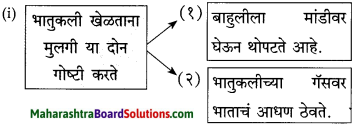
![]()
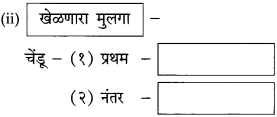
उत्तर:
(१) उंच उडवतो.
(२) हातात झेलतो.
(iii) या दोन गोष्टी करण्याचा आत्मविश्वास मुलीकडे आहे.
(१) ……………………………….
(२) ………………………………
उत्तर:
(१) चेंडू उंच उडवून झेलू शकते.
(२) पाल्याची भाजी बनवू शकते.
(iv) गॅससमोर मांडी घालून मुलगा पुढील कृती करतो –
(१) प्रथम – ……………………………….
(२) नंतर – ……………………………….
उत्तर:
(१) दोन्ही हातांनी बाहुलीला थोपटतो.
(२) भाजीसाठी पातेले शोधतो.
(v) मुलगा व मुलीचे वास्तव चित्र कसे दिसेल?
(१) ……………………………….
(२) ……………………………….
उत्तर:
(१) दोघांचाही हातात हात असेल.
(२) दोघांच्या हातात बाहुली आणि चेंडू जोडीने
तापलेल्या उन्हाच्या आडोशाला बसून
खेळते आहे एक मुलगी केव्हाची.
मी पाहत राहते तिला माझ्या घराच्या झरोक्यातून.
ती मांडीवर घेते बाहुलीला
एका हातानं थोपटत तिला, चढवते आधण भाताचं
भातुकलीतल्या इवल्याशा गॅसवर. ![]()
बाजूला खेळतो आहे मुलगा हातात चेंडू घेऊन
खूप उंच उडवून चेंडू नेमका झेलतो तो हातात.
मुलगी पाहत राहते कौतुकानं त्याच्याकडे.
अचानक बाजूला ठेवून बाहुलीला ती जवळ जाते त्याच्या.
मुलगा दाखवतो तिला आपलं कसब पुन्हा एकदा.
मुलगी चेंडू मागते त्याच्याकडे
तेव्हा तो हसून म्हणतो,
‘तू भाजी बनव छानपैकी पाल्याची.’ ती म्हणते,
‘मी दोन्ही करू शकते एकाच वेळी, तू करशील?’
मुलगा देतो चेंडू तिच्या हातात.
उंच उडवलेला चेंडू आभाळाला शिवून
नेमका येऊन पडतो तिच्या ओंजळीत.
मुलगा पाहत राहतो आश्चर्यचकित.
तशी हसून म्हणते ती, ‘आता तू.’
मांडी घालून मुलगा बसतो गॅससमोर.
दोन्ही हातांनी थोपटत झोपवतो बाहुलीला प्रथम;
मग शोधतो पातेलं भाजीसाठी…
हळूहळू शिकेल तोही ![]()
आपलं कसब दाखवतानाच घर सांभाळणं
तापलेल्या उन्हाच्या आडोशाला बसून.
माझ्या घराच्या झरोक्यातून दिसतं आहे
एक आश्वासक चित्र उदयाच्या जगाचं
जिथं खेळले जातील सारेच खेळ एकत्र.
भातुकलीतून प्रवेशताना वास्तवात
हातात हात असेल दोघांचाही
ज्यावर सहज विसावेल बाहुली आणि चेंडू जोडीनं.
– (निरर्थकाचे पक्षी)
कृती २ : (आकलन)
प्रश्न 1.
पुढील ओळींचा सरळ अर्थ लिहा :
हळूहळू शिकेल तोही
आपलं कसब दाखवतानाच घर सांभाळणं
उत्तर:
सरळ अर्थ : तो मुलगा आपले कौशल्य दाखवता दाखवता घर-प्रपंच सांभाळणेही शिकेल.
प्रश्न 2.
योग्य पर्याय निवडा :
(i) मुलगा आश्चर्यचकित झाला; कारण …………………………
(१) मुलीने चेंडू हातात पकडला नाही.
(२) मुलीने चेंडू उंच उडवून हातात झेलला.
(३) मुलीला चेंडू खेळता येईना.
(४) मुलीला गर्व झाला होता.
उत्तर:
मुलगा आश्चर्यचकित झाला; कारण मुलीने चेंडू उंच उडवून हातात झेलला.
(ii) मुलगा मांडी घालून गॅससमोर बसला; कारण …………………………
(१) मुलीने भाजी करायला सांगितले नाही.
(२) मुलीने भाजी करण्याचे आवाहन त्याला केले.
(३) त्याला भाजी करण्याची आवड होती.
(४) त्याचा मुलीवर राग होता.
उत्तर:
मुलगा मांडी घालून गॅससमोर बसला; कारण मुलीने भाजी करण्याचे आवाहन त्याला केले.
![]()
(iii) आपलं कसब दाखवताना हळूहळू शिकेल तोही …………………………
(१) चेंडू टोलवणं
(२) घर सांभाळणं
(३) अभ्यास करणं
(४) भातुकली नाकारणं
उत्तर:
आपलं कसब दाखवताना हळूहळू शिकेल तोही घर सांभाळणं.
(iv) माझ्या घराच्या झरोक्यातून दिसतं आहे, उद्याच्या जगाचं एक …………………………
(१) नश्वर चित्र
(२) स्पष्ट चित्र
(३) विचित्र चित्र
(४) आश्वासक चित्र
उत्तर:
माझ्या घराच्या झरोक्यातून दिसतं आहे, उदयाच्या जगाचं एक आश्वासक चित्र,
प्रश्न 3.
चौकटी पूर्ण करा :
(i) मुलगी येथे बसून खेळत आहे →
(ii) कवयित्री मुलीला इथून पाहत आहे →
(iii) मुलगा मुलीला ही भाजी करायला सांगतो →
(iv) मुले भातुकलीतून येथे प्रवेश करतील →
(v) या काव्यसंग्रहातून प्रस्तुत कविता घेतली →
उत्तर:
(i) तापलेल्या उन्हाच्या आडोशाला
(ii) घराच्या झरोक्यातून
(iii) पाल्याची
(iv) वास्तवात
(v) निरर्थकाचे पक्षी
![]()
कृती ३ : (काव्यसौंदर्य)
प्रश्न 1.
‘माझ्या घराच्या झरोक्यातून दिसतं आहे
एक आश्वासक चित्र उदयाच्या जगाचं
जिथं खेळले जातील सारेच खेळ एकत्र.’
या ओळींतील विचारसौंदर्य स्पष्ट करा.
उत्तर :
कवयित्री नीरजा यांनी ‘आश्वासक चित्र’ या कवितेत स्त्री-पुरुष समानतेचे भविष्यकालीन उत्साहवर्धक चित्र रेखाटले आहे.
कवयित्री आपल्या घराच्या खिडकीतून मुलामुलीचा खेळ पाहत आहेत. मुलगी भातुकलीचा खेळ खेळत असते व मुलगा चेंडू उडवत असतो. थोड्या वेळाने त्यांना दिसते की, मुलगी सहजपणे चेंडू उडवून झेलत आहे आणि मुलगा भातुकलीतला खेळ खेळत आहे. हा परस्परांचा स्नेहभाव व सहभाग पाहून कवयित्री म्हणतात की, हे उदयाच्या जगातले आश्वासक चित्र आहे. स्त्री-पुरुष समानता येऊ घातलीय. भविष्यात सारेच खेळ एकत्र खेळले जातील. स्त्री-पुरुष एकमेकांची कामे सहकार्याने व सामंजस्याने एकत्रित करतील. स्त्री-पुरुष समानतेचे भविष्यकालीन चित्र सूचक पद्धतीने या ओळीत रेखाटले आहे.
प्रश्न 2.
कवितेतला मुलगा हळूहळू काय शिकेल ते तुमच्या भाषेत लिहा.
उत्तर:
मुलगी भातुकलीचा खेळ खेळत असते, तर मुलगा चेंडू झेलण्याचा खेळ खेळत असतो. अचानक ती मुलगी मुलाजवळ जाते इ व चेंडू मागते. मुलाला वाटते, ही चेंडू झेलू शकणार नाही, म्हणून तो हिणवल्या स्वरात तिला म्हणतो की, तू पाल्याची भाजी करण्याचे बायकी काम कर. ती मुलगी म्हणते की, मी दोन्ही कामे करू शकते. है तू करशील? मुलगा तिला चेंडू देतो व ती तो उंच उडवून लीलया इ झेलते. ती हसून मुलाला म्हणते – आता तुझी पाळी. तू माझे काम कर, मुलगा गॅससमोर बसतो. बाहुलीला थोपटतो व भाजीसाठी पातेले शोधतो. हा मुलामधला बदल पाहताना कवयित्री म्हणतात – मुलगा हळूहळू घर सांभाळायला शिकेल. पुरुषातला हा आश्वासक बदल कवयित्रींना अभिप्रेत आहे.
Marathi Kumarbharti Class 10 Textbook Solutions Chapter 9 आश्वासक चित्र Additional Important Questions and Answers
कृतिपत्रिकेतील प्रश्न २ (आ) साठी…
प्रश्न. पुढील कवितेसंबंधी त्याखाली दिलेल्या मुद्द्यांच्या आधारे कृती सोडवा :
कविता-आश्वासक चित्र.
उत्तर :
(१) प्रस्तुत कवितेच्या कवयित्री : नीरजा.
(२) कवितेचा रचनाप्रकार : मुक्तछंद.
(३) कवितेचा काव्यसंग्रह : निरर्थकाचे पक्षी.
(४) कवितेचा विषय : स्त्री-पुरुष समानता.
(५) कवितेतून व्यक्त होणारा (स्थायी) भाव : स्त्री-पुरुष समानता येणारच, हा कवयित्रींच्या मनातला आशावाद.
(६) कवितेच्या कवयित्रींची लेखनवैशिष्ट्ये : ही मुक्तछंदातली कविता आहे. मुक्तछंदामुळे दैनंदिन व्यवहारातली भाषा कवितेत वापरली गेली आहे. साध्या विधानांतून कवयित्री खोलवरचे विचार मांडतात, लहान मुलांच्या खेळाचे चित्रण हे या कवितेतील सुंदर प्रतीक आहे. या प्रतीकातून आधुनिक जगातील स्त्री-पुरुष समानता हा फार मोठा विचार अगदी सहजपणे व्यक्त होतो. हातात हात असेल’ या वाक्यखंडातून कवितेतील मुलगा व मुलगी यांच्या भावी आयुष्यातील सामंजस्य प्रत्ययकारकतेने प्रकट होते. ![]()
(७) कवितेची मध्यवर्ती कल्पना : सध्याच्या काळाकडे लक्ष टाकले, तर असे जाणवेल की, आजच्या या युगातही स्त्रियांना समाजात दुय्यम स्थान दिले जाते. पण कवयित्रींना दोन लहान मुले खेळतांना दिसतात. त्यांच्यात हळूहळू सामंजस्य निर्माण होत जाताना दिसते. हीच मुले मोठी होतील, तेव्हा हे सामंजस्य घेऊन वागू लागतील आणि समाजात स्त्री-पुरुष समानता प्रस्थापित होईल, अशी आशा कवयित्रींच्या मनात जागी होते. हा आशावाद, हीच या कवितेची मध्यवर्ती कल्पना आहे.
(८) कवितेतून व्यक्त होणारा विचार : अजूनही समाजाने पूर्णपणे स्त्री-पुरुष समानता अंगीकारलेली नाही. हे निराशाजनक आहे. परंतु भावी काळ हा स्त्री-पुरुष समानतेचाच असणार आहे. म्हणून सर्वांनी स्त्री-पुरुष समानतेचे तत्त्व आतापासूनच मान्य करून ते अंगीकारले पाहिजे, असा विचार या कवितेतून मांडला आहे.
(९) कवितेतील आवडलेली ओळ :
हळूहळू शिकेल तोही
आपलं कसब दाखवतानाच घर सांभाळणं
तापलेल्या उन्हाच्या आडोशाला बसून.
(१०) कविता आवडण्याची वा न आवडण्याची कारणे : ही कविता मला खूप आवडली आहे. ही आजची, आमच्या पिढीची कविता आहे. आमच्या मनातला भाव, आमचे विचार या कवितेतून व्यक्त होतात. आम्ही आपापसात वागतो, तेव्हा मुलगा-मुलगी असा भेदच आमच्या मनात नसतो, श्रेष्ठ-कनिष्ठभाव न बाळगता आम्ही वावरत असतो. आमच्या मनातला हा भावच ही कविता व्यक्त करते.
(११) कवितेतून मिळणारा संदेश : आजपर्यंत आपण स्त्रियांना दुय्यम मानून वागत आलो. हे आता खूप झाले. आता हे थांबले पाहिजे, येणारा काळ हा स्त्री-पुरुष समानतेचा काळ आहे. त्या काळाला साजेसे जीवन जगण्यासाठी आपल्याला आता स्त्री-पुरुष समानतेचे तत्त्व अंगीकारावे लागणार आहे.
व्याकरण व भाषाभ्यास
कृतिपत्रिकेतील प्रश्न ४ (अ) आणि (आ) यांसाठी…
व्याकरण घटकांवर आधारित कृती :
१. समास:
सामासिक शब्द व विग्रह – जोड्या लावा :
सामासिक शब्द – विग्रह
(i) यथामती – (अ) धास्तीशिवाय
(ii) मतिमंद – (आ) बुद्धीप्रमाणे
(i) गणेश – (इ) माहीत न असता
(iv) बिनधास्त – (ई) गणांचा देव
(v) बेमालूम – (उ) बुद्धीने कमकुवत
उत्तर:
सामासिक शब्द – विग्रह
(i) यथामती – बुद्धीप्रमाणे
(ii) मतिमंद – बुद्धीने कमकुवत
(iii) गणेश – गणांचा देव
(iv) बिनधास्त – धास्तीशिवाय
(v) बेमालूम – माहीत न असता
![]()
२. अलंकार :
पुढील अभंगातील अलंकार ओळखून स्पष्टीकरण करा :
‘हरिणीचे पाडस । व्याघ्र धरियेले
मजलागी जाहले । तैसे देवा ।।’
उत्तर :
अलंकार : हा दृष्टान्त अलंकार आहे. स्पष्टीकरण : देवाच्या दर्शनासाठी व्याकुळ झालेल्या संत कान्होपात्रा यांनी आपल्या मनाची स्थिती व्यक्त करताना एक दाखला दिला आहे. वाघाने हरिणीचे पाडस घरले; तर त्या पाडसाची जशी दयनीय अवस्था होते, तशी हे देवा, या संसारात तुझ्याशिवाय माझी अवस्था झाली आहे. विचार व्यक्त करताना इथे दृष्टान्त दिला आहे; म्हणून हा दृष्टान्त अलंकार आहे.
३. वृत्त:
पुढील ओळींचे गण पाडून वृत्त ओळखा :
झुरे आज वारा कशाने कशाने
तुटे दूर तारा कशाने कशाने
उत्तर :

हे भुजंगप्रयात वृत्त आहे.
४. शब्दसिद्धी :
(i) मनः’ हा उपसर्ग लावून दोन शब्द तयार करा :
जसे : मनः + वृत्ती → मनोवृत्ती
(१) [ ]
(२) [ ]
उत्तर:
(१) मनोकामना
(२) मनोव्यापार
(ii) ‘पुनः’ हा उपसर्ग लावून दोन शब्द तयार करा :
(१) [ ]
(२) [ ]
उत्तर:
(१) पुनरागमन
(२) पुनरावृत्ती
![]()
(iii) ‘ता’ हा प्रत्यय लावून दोन शब्द तयार करा :
जसे : अस्वस्थ +ता → अस्वस्थता.
(१) [ ]
(२) [ ]
उत्तर:
(१) नम्रता
(२) सुंदरता
५. सामान्यरूप :
तक्ता पूर्ण करा:
| शब्द | मळ शब्द | प्रत्यय | सामान्यरूप |
| (i) तिला | ……………………….. | ……………………….. | ……………………….. |
| (ii) बाहुलीला | ……………………….. | ……………………….. | ……………………….. |
| (iii) हातांनी | ……………………….. | ……………………….. | ……………………….. |
| (iv) ओंजळीत | ……………………….. | ……………………….. | ……………………….. |
| (v) उन्हाच्या | ……………………….. | ……………………….. | ……………………….. |
| (vi) आडोशाला | ……………………….. | ……………………….. | ……………………….. |
उत्तर :
| शब्द | मळ शब्द | प्रत्यय | सामान्यरूप |
| (i) तिला | ती | ला | ती |
| (ii) बाहुलीला | बाहुली | ला | बाहुली |
| (iii) हातांनी | हात | नी | हातां |
| (iv) ओंजळीत | ओंजळ | त | ओंजळी |
| (v) उन्हाच्या | उन्ह | च्या | उन्हा |
| (vi) आडोशाला | आडोसा | ला | आडोशा |
६. वाक्प्रचार :
योग्य अर्थ निवडा:
(i) आश्चर्यचकित होणे – (भीती वाटणे/थक्क होणे)
(ii) कसब दाखवणे – (खूप खेळणे/कौशल्य दाखवणे)
(iii) हातात हात असणे – (सहकार्य करणे/एकत्र चालणे)
उत्तर: :
(i) आश्चर्यचकित होणे – थक्क होणे.
(ii) कसब दाखवणे – कौशल्य दाखवणे.
(iii) हातात हात असणे – सहकार्य करणे.
![]()
(भाषिक घटकांवर आधारित कृती :
१. शब्दसंपत्ती :
प्रश्न 1.
विरुद्धार्थी शब्द लिहा :
(i) ऊन
(ii) हसून
(iii) आता
(iv) वास्तव.
उत्तर:
(i) ऊन x सावली
(ii) हसून x रडून
(iii) आता x नंतर
(iv) वास्तव x अवास्तव.
प्रश्न 2.
गटात न बसणारा शब्द लिहा :
(i) चेंडू, खेळणे, बाहुली, भिंगरी, भोवरा. →
(ii) खिडकी, दरवाजा, घर, जिना, पायऱ्या. →
(iii) सदन, सधन, भवन, निकेतन. → (मार्च ‘१९)
(iv) जल, नभ, गगन, आकाश. → (मार्च ‘१९)
उत्तर:
(i) चेंडू, खेळणे, बाहुली, भिंगरी, भोवरा → खेळणे
(ii) खिडकी, दरवाजा, घर, जिना, पायऱ्या → घर
(iii) सदन, सधन, भवन, निकेतन → सघन
(iv) जल, नभ, गगन, आकाश → जल
प्रश्न 3.
पुढील शब्दांच्या अक्षरांपासून चार अर्थपूर्ण शब्द लिहा :
(i) बाहुलीला →
(ii) आभाळाला →
उत्तर:
(i) बाहुलीला → बाहु – लीला – लाली – बाला
(ii) आभाळाला → आभा – आळा – आला – भाला
२. लेखननियम:
अचूक शब्द लिहा :
(i) बाहुलि/बाहूली/बाहूलि/बाहुली.
(ii) क्षीतीज/क्षितिज/क्षितीज/क्षीतिज,
(iii) सहानुभूती/सहानुभुती/सहानूभुती/सहानुभूति.
(iv) उपस्थिती/उपस्थीती/उपस्थीति/ऊपस्थिति.
उत्तर:
(i) बाहुली
(ii) क्षितिज
(iii) सहानुभूती
(iv) उपस्थिती.
![]()
३. विरामचिन्हे:
पुढील ओळींतील विरामचिन्हे ओळखा :
तशी हसून म्हणते ती, ‘आता तू.’
उत्तर:
[ , ] स्वल्पविराम
[ . ] पूर्णविराम
[ ‘ ‘ ] एकेरी अवतरणचिन्ह.
४. पारिभाषिक शब्द :
अचूक मराठी पारिभाषिक शब्द निवडा :
(i) Affedevit – …………………………………
(१) परिपत्र
(२) शपथपत्र
(३) प्रतिज्ञा
(४) आज्ञा.
उत्तर:
(१) शपथपत्र
(ii) Dismiss –
(१) बडतर्फ
(२) शेवट
(३) हुद्दा
(४) मुद्दा.
उत्तर:
(१) बडतर्फ
![]()
(iii) Translator –
(१) अनुमोदक
(२) अनुवाद
(३) भाषांतर
(४) अनुवादक.
उत्तर:
(४) अनुवादक.
५. अकारविल्हे/भाषिक खेळ :
पुढील शब्द अकारविल्हेनुसार लिहा :
(i) बाहुली → खेळ → भाजी → मुलगी.
(ii) चेंडू → घर → ऊन → आडोसा.
उत्तर:
(i) खेळ → बाहुली → भाजी → मुलगी.
(ii) आडोसा → ऊन → घर → चेंडू.
आश्वासक चित्र Summary in Marathi
दुपारच्या वेळी ऊन तापलेले आहे. आडोशाला सावलीत बसून एक मुलगी, बराच वेळ झाला तरी खेळते आहे. हे दृश्य कवयित्री स्वत:च्या घराच्या खिडकीतून पाहत राहिली आहे.
ती मुलगी एकटीच भातुकलीचा खेळ खेळते आहे. ती बाहुलीला मांडीवर घेऊन एका हाताने तिला थोपटत निजवते आहे. (बाळाला आई मांडीवर घेऊन निजवते तसे.) नंतर ती भात शिजवण्यासाठी आधणाचे पातेले चिमुकल्या गॅसवर ठेवते. (तिचा लुटुपुटीचा संसार सुरू आहे.)
बाजूला एक मुलगा हातात चेंडू घेऊन उंच उडवून पुन्हा नेमका हातात झेलण्याचा खेळ खेळतो आहे.
मुलगी त्या मुलाचा चेंडूचा खेळ कौतुकाने पाहते. अचानक मांडीवरची बाहुली बाजूला ठेवून ती त्या मुलाजवळ जाते. मुलगा पुन्हा एकदा चेंडू उंच उडवून झेलण्याचे कौशल्य तिला दाखवतो. मुलगी त्याच्याकडे चेंडू मागते. (मुलाला वाटते या मुलीला माझा चेंडूचा खेळ जमणार नाही.) तेव्हा हसून तो तिला म्हणतो – “तू छानपैकी पालेभाजी बनव.” (भातुकलीचा खेळ, भाजी करणे हे तुझे काम ! तुला पुरुषी कामे काय जमणार ?) मुलगी त्याला म्हणते- “मी दोन्ही कामे (स्त्रीची व पुरुषाची) एकाच वेळी करू शकते. तू करू शकशील का?” (तू स्त्रीची कामे करशील ? ) मुलगा स्वतःच चेंडू तिच्या हातात देतो.
मुलगी चेंडू उंच उडवते. तो आभाळाला जणू स्पर्श करून नेमकेपणाने तिच्या ओंजळीत येऊन पडतो. (मुलगी चेंडू व्यवस्थित झेलते.) हे ‘ पाहून मुलगा आश्चर्याने तिच्याकडे पाहतो. (आपल्यासारखाच तिने चेंडू झेलला हे पाहून मुलगा चकित होतो.) मुलगी मुलाला म्हणते- “आता तुझी पाळी ! तू माझे काम करून दाखव.” मुलगा चिमुकल्या गॅससमोर मांडी घालून बसतो. प्रथम दोन्ही हातांनी थोपटत बाहुलीला निजवतो. मग भाजी करण्यासाठी टोप शोधतो…
कवयित्री म्हणतात-तापलेल्या उन्हात सावलीच्या आडोशाला बसून तो मुलगा आपले कौशल्य दाखवता दाखवता घर सांभाळणेही हळूहळू शिकेल. (हळूहळू तो संसारातील स्त्रियांची घरगुती कामेही शिकेल.)
माझ्या घराच्या खिडकीतून मला भविष्यातल्या जगाचे विश्वासार्ह व उत्साहवर्धक चित्र दिसते आहे. उदयाच्या जगात सारेच खेळ स्त्री आणि पुरुष एकत्र खेळतील, असे मला वाटते आहे. भातुकलीच्या स्वप्नाळू जगातून प्रत्यक्ष वास्तवात प्रवेश करताना या दोन्ही मुलांचा (स्त्री-पुरुषाचा) हात एकमेकांच्या हातात असेल ज्या हातांवर बाहुली आणि चेंडू स्नेहाने सहज एकत्र विसावलेले असतील. (स्त्री-पुरुषांमध्ये भविष्यात परस्पर सामंजस्य व स्नेहभाव निर्माण होऊन स्त्री-पुरुष समानता नक्कीच येईल.)
आश्वासक चित्र शब्दार्थ
- आश्वासक – विश्वासार्ह, उत्साहवर्धक, प्रोत्साहक,
- आडोशाला – आश्रयाला.
- झरोक्यातून – खिडकीतून.
- इवल्याशा – चिमुकल्या.
- गॅसवर – गॅसच्या चुलीवर.
- कसब – कौशल्य, कुशलता.
- पाल्याची भाजी – पालेभाजी.
- शिवून – स्पर्श करून,
- पातेलं – टोप.
- घर सांभाळणं – घराची देखभाल करणे, संसार चालवणे. वास्तवातप्रत्यक्षात.
- विसावेल – विश्रांती घेईल, जोडीनं – सोबतीने.
Must Read:
Marathi Kumarbharti Class 10 Textbook Solutions
